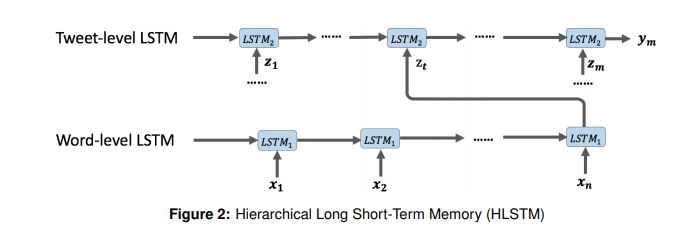This is a brief summary of paper for me to study and organize it, Modeling Rich Contexts for Sentiment Classification with LSTM (Huang et al., arXiv 2016) I read and studied.
They propose how to get representation with rich context in tweets which constitute a thread like conversation.
They used two types of LSTM, one is Word-level LSTM, the other is Tweet-level LSTM as above figure.
The word-level encode a tweet into the fixed-size vector.
and the Tweet-level use the vectors from word-level LSTM as input.
In other word,
From Figure 2 we can see that in the word-level LSTM, the input is individual words.
The hidden state of the last word is taken as the representation of the tweet.
Each tweet in a thread will go through the word-level LSTM, and the t-th tweet in the thread will generate a tweet representation of zt which will be an input of the tweet-level LSTM.
And the extend input of tweet level LSTM with context featues which represent as binary value.
The additional context feature is as follows:
- SameAuthor
- Converstaion
- SameHashtag
- SameEmoji
Modeling Rich Contexts for Sentiment Classification with LSTM (Huang et al., arXiv 2016)
Reference
- Paper
- How to use html for alert
